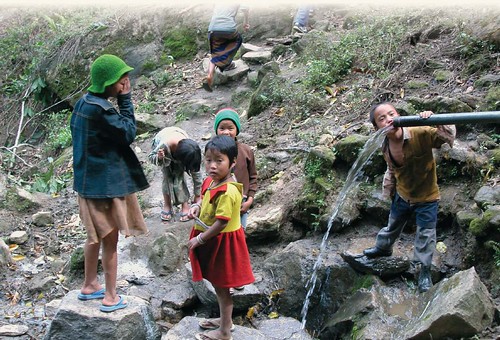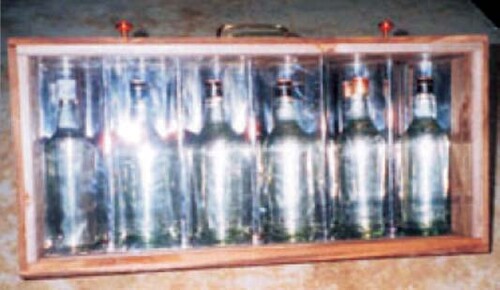Source
Kurukshetra Ministry of Rural Development, May 2010
Every 8 seconds, a child dies from water related disease around the globe. 50% of people in developing countries suffer from one or more water-related diseases. 80% of diseases in the developing countries are caused by contaminated water.
Impure water is the root cause for many diseases especially in developing countries. Millions of people become sick each year from drinking contaminated water. In many regions of the world, sunshine is abundantly available which can be effectively utilised to provide safe drinking water to the millions of people. A portable, low-cost, and low-maintenance solar disinfection unit to provide potable water has been designed and tested. The solar disinfection system has been tested with bore water, well as well as waste water. In 5 hours, the unit eradicated 3 log 10 (99.99%) of bacteria contained in the water samples. The unit will provide about 6 liters of pure drinking water and larger units can be fabricated for providing safe drinking water at community level in developing countries.

Introduction
Every 8 seconds, a child dies from water related disease around the globe. 50% of people indeveloping countries suffer from one or more waterrelated diseases. 80% of diseases in the developing countries are caused by contaminated water. Providing safe drinking water to the people has been a major challenge for Governments in developing countries. Conventional technologies used to disinfect water are: ozonation, chlorination and artificial UV radiation. These technologies require sophisticated equipment, are capital intensive and require skilled operators (1,17,20). Boiling water requires about 1 kg of wood/liter of water which results in deforestation in developing countries. Also halazone or calcium hypochlorite tablets or solutions (sodium hypochlorite at 1 to 2 drops per liter) are used to disinfect drinking water. These methods are environmentally unsound or hygienically unsafe when performed by a layperson. Misuse of sodium hypochlorite solution poses a safety hazard.
Treatment to control waterborne microbial contaminants by exposure to sunlight in clearvessels that allows the combined germicidal effects of both UV radiation and heat has been developed and put into practice . The SODIS system (Solar Disinfection of water) developed by scientists at the Swiss Federal Agency for Environmental Science and Technology(EA WAG ) recommends placing PET bottles (usually discarded mineral water/beverage bottles)painted black on one side, aerating (oxygenating) the water by vigorous shaking three fourths water filled bottles and then filling them full and placing them in sunlight for 6 hours. In this method, the water is exposed to UV radiation in sunlight, primarily UV-Aand it becomes heated; both effects contribute to the inactivation of water borne microbes. The use of PET bottles requires periodic replacement because of scratches and they become deformed if temperature exceeds 650C. Also dust accumulates on these bottlesin the groves (provided for strength). The PET bottle mineral water manufacturers print on the label,’ crush the bottle after use’ in India. Unless cleaned thoroughly everyday, PET bottles turn brown over usage rendering lesser transmission of sunlight.
Microorganisms are heat sensitive. It can be seen that it is not required to boil the water in order to kill 99.9% of the microorganisms. Heating up water to 50 - 600C for one hour has the same effect (2,21).
Low Cost Technologies
The need for a low-cost, low maintenance and effective disinfection system for providing safe drinking water is paramount, especially for the developing countries.
Materials And Methods
The innovative solar disinfection system has a wooden frame of length 2 ft,width 1 foot and depth 6 inches with bottom sinusoidal shaped polished stainless steel (curvature slightly larger than standard glass wine bottles, about 5 inches diameter) . On the front is fixed a glass sheet having lifting arrangement with a knob (this glass enclosure will protect theglass bottles from cooling down due to outside wind). There are screws which can be used to keep the contents airtight. On the backside a stand is fixed which will help the unit to be placed according to the latitude of the place for maximum solar insolation.
In this method clear glass bottles (used wine bottles) are utilised instead of PET bottles as the former are easy to clean, lasts longer and are available at a low cost in India. Solar disinfection is more efficient in water containing high levels of oxygen; sunlight produces highly reactive forms of oxygen (oxygen free radicals and hydrogen peroxides) in the water. These reactive forms of oxygen kill the microorganisms. Aeration of water is achieved byshaking the 3/4 water filled bottles for about 20 seconds before they are filled completely.
The unit has an advantage in that the rear reflection stainless steel will pass the light throughthe bottles a second time, to both increase exposure and eliminate shadowing. This reflection system will increase the light intensity minimum 2 times.
 It has been widely experimented and established by earlier researchers that at temperature of 500C, pathogenic microbes are inactivated. The temperatures which cause approximately a 1-log decrease in viability with 1 min are 550C for protozoan cysts; 600C for E.coli, enteric bacteria, and rotavirus; and 650C for hepatitis A virus (3,6,8,9,10,16). Negar Safapourand Robert H.Metcalf (15) in their extensive studies reported enhancement of solar water pasteurization with reflectors and the crucial role of temperature above 500C in the elimination of pathogens.
It has been widely experimented and established by earlier researchers that at temperature of 500C, pathogenic microbes are inactivated. The temperatures which cause approximately a 1-log decrease in viability with 1 min are 550C for protozoan cysts; 600C for E.coli, enteric bacteria, and rotavirus; and 650C for hepatitis A virus (3,6,8,9,10,16). Negar Safapourand Robert H.Metcalf (15) in their extensive studies reported enhancement of solar water pasteurization with reflectors and the crucial role of temperature above 500C in the elimination of pathogens.Operation
The unit is placed in the south direction (in India) around 10 am with inclination equal to the latitude of the place. The glass bottles are filled with water three fourths and shaken for 20 seconds to generate oxygen and then completely filled. The water filled bottles are fixed with caps and put in the groves of the solar disinfection unit. The glass door is closed and clipped airtight. Water bottles are removed from the unit at 3 pm and taken to a cool place andthe disinfected water transferred to a clean vessel, covered for later usage.
Suspended particles in the water reduce the penetration of solar radiation into the water andprotect microorganisms from being irradiated. Solar disinfection requires relatively clear water with a turbidity less than 30 NT U.To remove turbidity traditional methods of putting the paste from seed of strichnos potatorum (Nirmal seeds) by rubbing the seed on a rough stone with water is used. The method is effective, turbidity settles down in half of an hour and the seed are available in plenty in forests in India besides being inexpensive.
Use of Solar System
Eradication of coli forms from well water, bore water and waste water has been reportedfrom test results. The results confirm that there is 4-log 10 reduction of coli forms in the waste water after solar disinfection. The experiments were conducted at Kavaraipettai,Tamil Nadu, India. Maximum temperature occurs around 1 pm. Though 6 bottles were used in the system (each of 1 liter capacity),larger units with up to 100 bottles can be designed. The unit destroyed 99.99% of bacterial coli forms both in well water and waste water samplesin 5 hours.
The innovative solar disinfection system has the advantages like:
1. T he unit is portable,
2. I t is cost-effective. It can be fabricated in South India for US$ 20.The unit incorporates theprinciple of reflection to increase solar intensity and has protection from wind which results intemperature rise inside the unit,
3. Larger units can be manufactured,
4. Used glass bottles withstand higher temperatures and are available in plenty eachfor 2 US cents in South India ,
5. Since all the materials are available locally, the unit can be manufactured locally with localpeople. Temperatures above 300c occur in south India for more than 10 months in a yearand as such this innovative solar disinfection unit will be a boon in this region.
The project is financially supported by Science and Society Division, Department of Science and Technology, Government of India.
(The author is Head, Centre for Energy and Sustainable Resources, R.M.K.Engineering College, Kavaraipettai 601 206, Tamil Nadu, e-mail:a_jagadeesh2@yahoo.com and anumakonda. jagdeesh@gmail.com)




